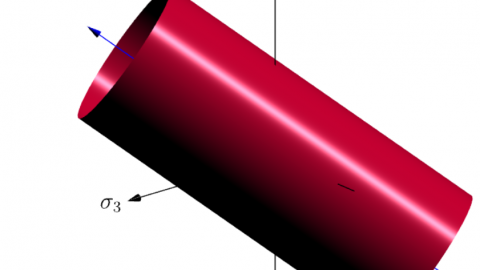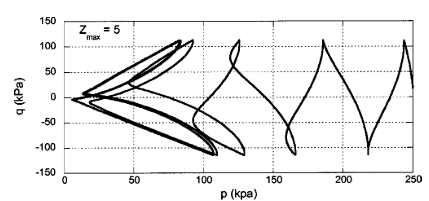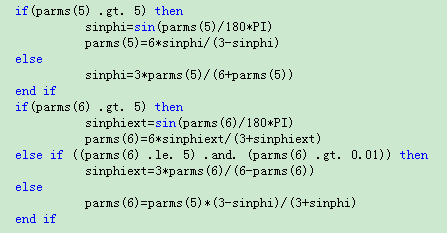Greetings
i used interface Vumat with Umat for simulating CEL problem, after 50% of analysis, i got the error as “Excessive incremental rotation of the elements in element set ” i researched the meaning about this error in literature but h couldn’t find how fix it. Anybody can help me and advise.
Regards
CEL analysis using hypo plasticity Vumat
Related Articles
-
-
Issues in getting the negative values of q (mean deviatoric stress) while simulating cyclic triaxial test in ABAQUS using SANISAND subroutine.
 MOHD SAQIB||Constitutive Modelling|5 |Views 4,329
MOHD SAQIB||Constitutive Modelling|5 |Views 4,329
Hello Everyone, I have been trying to simulate the cyclic triaxial test using the SANISAND04 subroutine. When I plotting the stress path (p-q plot), I am getting only the positive […] -
ERROR Message when using UMAT_hcea with ABAQUS
 Lukas Reindl||Constitutive Modelling|3 |Views 4,529
Lukas Reindl||Constitutive Modelling|3 |Views 4,529
Hi all! I am modelling some triaxial compressions in ABAQUS with Weald Clay. The constitutive law i am using is the clay hypoplasticity by Mašín. When running the program using […] -
Question on the Matlab driver – model hypo Sand
 c sx||Constitutive Modelling|1 |Views 3,973
c sx||Constitutive Modelling|1 |Views 3,973
As a beginner to soil constitutive modelling, I am learning the hypoplastic models by reading the matlab drivers. I am confused with the matlab file f_hyp.m in the model hypo_sand. […] -
Cyclic tests with Triax element test driver
 Konstantinos Chatzis||Constitutive Modelling|8 |Views 998
Konstantinos Chatzis||Constitutive Modelling|8 |Views 998
Dear all, I am attempting to utilize the triax driver for simulating cyclic triaxial tests. However, I have been unable to locate the command for conducting cyclic tests within the […] -
Question about Interface between UMAT and VUMAT
 Sina Niazi||Constitutive Modelling|1 |Views 4,341
Sina Niazi||Constitutive Modelling|1 |Views 4,341
Hello, I read the research report and the FORTRAN code available at https://soilmodels.com/download/vumat_umatinterface-zip/. It sounds quite interesting but I have a couple of questions about the FORTRAN code: 1- Did […] -
Problems with the UMAT subroutine check_parms_DM of the SANISAND constitutive model
 meng xiaowei||Constitutive Modelling|3 |Views 4,370
meng xiaowei||Constitutive Modelling|3 |Views 4,370
Where can I find the source of the content in the picture below in the UMAT subroutine check_parms_DM of the SANISAND constitutive model? -
ExCalibre Automatic Calibration
 Marco Hofer||Constitutive Modelling|5 |Views 4,160
Marco Hofer||Constitutive Modelling|5 |Views 4,160
Hello all, i have another question regarding the calibration process. Why do the initial void ratios differ between the input file and the output from excalibre? What is done during […]
Who is Online
No one is online right now
Search SoilModels Website
Recent posts
-
 Degradation ( disturbance ) of hypoplastic clay 23.4.2024
Degradation ( disturbance ) of hypoplastic clay 23.4.2024
-
 Degradation ( disturbance ) of hypoplastic clay 23.4.2024
Degradation ( disturbance ) of hypoplastic clay 23.4.2024
-
 Paper of Coulomb, C. A. (1773) 15.4.2024
Paper of Coulomb, C. A. (1773) 15.4.2024
-
 ABAQUS UMAT of hypoplastic clay model 6.4.2024
ABAQUS UMAT of hypoplastic clay model 6.4.2024
-
 Prague Geotechnical Days 2024 “Geotechnical monitoring” and 30th jubilee Prague Geotechnical Lecture by prof. Eduardo Alonso 5.4.2024
Prague Geotechnical Days 2024 “Geotechnical monitoring” and 30th jubilee Prague Geotechnical Lecture by prof. Eduardo Alonso 5.4.2024
-
 UMAT for Creep-SCLAY model. 1.3.2024
UMAT for Creep-SCLAY model. 1.3.2024
-
 Cyclic tests with Triax element test driver 14.2.2024
Cyclic tests with Triax element test driver 14.2.2024
-
 SUMMER SCHOOL ‘Numerical Modelling in Geotechnical Engineering’, Innsbruck – July 22nd-26th, 2024 1.2.2024
SUMMER SCHOOL ‘Numerical Modelling in Geotechnical Engineering’, Innsbruck – July 22nd-26th, 2024 1.2.2024
-
 COURSE IN SOIL MODELING – NTNU, Trondheim – October 14th to 18th, 2024 21.12.2023
COURSE IN SOIL MODELING – NTNU, Trondheim – October 14th to 18th, 2024 21.12.2023
-
 MSE walls design in Plaxis 11.12.2023
MSE walls design in Plaxis 11.12.2023
-
 sand liquefaction modelling in Anura3D 8.12.2023
sand liquefaction modelling in Anura3D 8.12.2023
-
 BCV bentonite experimental and modelling datasets 14.11.2023
BCV bentonite experimental and modelling datasets 14.11.2023
Recent Comments
- KHA DIDJA on Animating Soil Models
- Jh Xue on Undrained Tests with Clay Hypoplasticity Intergranular
- Zhentao Liu on Problem in simulating CPT using SANISAND04
- Gertraud Medicus on ABAQUS UMAT of hypoplastic clay model
- Chen Zhiming on Download Package of Charles University Implementation of High Cycle Accumulation Model
- Konstantinos Chatzis on Cyclic tests with Triax element test driver
- Abhay Pratap Singh on Cyclic tests with Triax element test driver
- Giovanni Ciardi on Cyclic tests with Triax element test driver
- Konstantinos Chatzis on Cyclic tests with Triax element test driver
- Ismail Khan on Cyclic tests with Triax element test driver
- Kanika Lamba on Cyclic tests with Triax element test driver
- Arie Koot on How to model the settlement in soil due to water drawdown.
- Konstantinos Chatzis on Cyclic tests with Triax element test driver
- Jose Duque on Cyclic tests with Triax element test driver
- MohamadReza Kamali on How to model the settlement in soil due to water drawdown.
- Leo Alibert on MSE walls design in Plaxis
- Ignacio Zuloaga on MSE walls design in Plaxis
- Giada Orlando on Problem with VUMAT interface






Hello Elfattah,
most probably your time step is too large. You can arbitrary decrease it with the “time scale factor” (maybe other name) in the “Step” module.
I recommend you should familiarize yourself with the theory of the CEL method. This might help you to solve the problem related to these error messages related to the CEL method in ABAQUS.
Best regards
Johannes
Dear Labenski
thank you for response, CEL depend on fixing the the mesh in space, so the distortion shall not be developed. i tried to reduce the time and mesh size, but the error is displayed after about 25 % instead of 50 % of analysis. Noted I used interface Vumat/Umat by Britta Bienen
Actually the mesh is not fixed as you might expect. The CEL method consists of three steps. In one step, the “fixed” mesh will be deformed according to the load and the corresponding material response. In a latter phase the deformed mesh will be resetted to its initial position, i.e. as user you think the mesh is fixed in space.
So reducing the time step with the time scaling factor (see image: https://imgur.com/a/kEHLYRy) usually worked for me to resolve this problem with CEL simulations. By standard I use a time scale factor of 0.9, but sometimes you may need even smaller factors. Of course, the computational time is increasing if you decrease this factor.
I see, i have already tried to use time scale factor to 0.5 and 0.85, but the error is displayed after about 25 % instead of 50 % of analysis. in addition, i tried too reduce the mesh size but i still receive the error. this error appear when i use Vumat. in contrast, the analysis has complete using anther constitutive law such as Mohr Coulomb or cap plasticity with the same model.
Did you receive this error before for CEL model ? and do you think that there problem in Vumat/Umat interface ?
I am using the Vumat-Umat interface for vibratory-pile installation simulations without problems. In most cases I could resolve this error with the time scale factor. You should also check if your boundary conditions are defined correct. You should only define boundary conditions you really need. Do not constrain all DOF at all boundaries, if you don’t need to.
the error element is existing at symmetry face near the contact zone
in addition, the energy balance is not normal. because the dramatically decreasing of total energy is occurred and the internal energy is very low. Noted, there is message state the the stretch element instead of gradient deformation
Hello
subscribe to and seek assistance from the
ABAQUS mailing list
https://groups.yahoo.com/neo/groups/Abaqus/info
Search the archive of the list before posting in it.
The list does not accept attachments.
Or
http://www.eng-tips.com/threadminder.cfm?pid=799
or from the ResearchGate discussion forum.
For advice on mechanics in general, including modeling,
you can consult
http://imechanica.org/
If you need subroutines: as an introduction get the file
http://imechanica.org/files/Writing User Subroutines with ABAQUS.pdf
Good luck
Frank